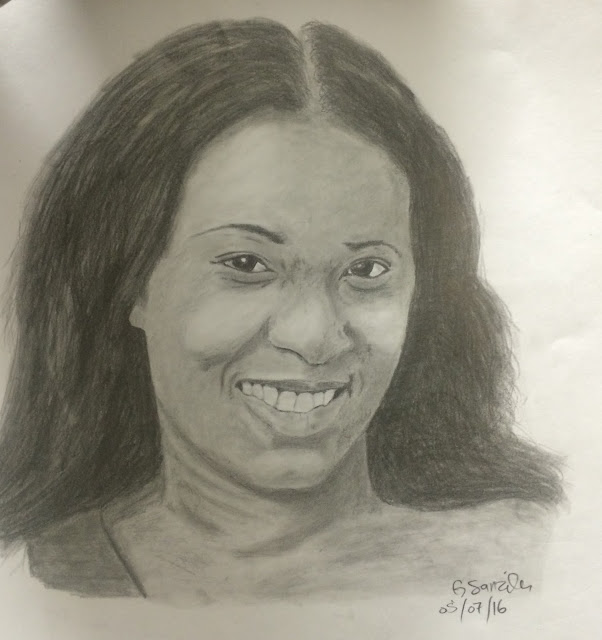Wednesday, July 6, 2016
Thursday, June 30, 2016
Art
Of all the gifts that life has to offer, a loving mother is the greatest of them all. #PencilArt #mothers #humanity
Monday, June 13, 2016
Art
 |
| "Those who fight and run away, live to fight another day". The legendary Bob Marley #pencilart #reggaemusic |
Thursday, June 9, 2016
Friday, May 27, 2016
Friday, May 13, 2016
Thursday, May 12, 2016
Art
Here I tried out the Fugees frontman Wyclef Jean. This guy's talent has had a profound effect on my life. He inspires me a lot. He can rap, sing, play Piano and Guitar and perhaps many other more instruments. He ran for President of Haiti, his native in 2010 but music won't let him go because that's his true passion. Such versatility has infused this burning desire inside of me to wanting to do more.
Tuesday, May 3, 2016
Art
 |
| Love or hate him Tupac Shakur remains one of most influential musicians to have graced the face of the earth. Profanity aside, his voice still resonates even after his death particularly among the downtrodden. #PencilArt |
Art
 |
| Gollum also known as Smèagol is a fictional character in the Lord of the rings trilogy. #PencilArt #MyPrecious. |
Wednesday, February 17, 2016
Nyango - Long journey to a resting place of Namibian heroes
 |
| One of dilapidated buildings that served as shelter for many Namibian refugees. Photo: George Sanzila |
The area of Nyango located in the Kaoma district some 400 kilometres west of Lusaka is rich in history and is likely to get a new lease of life in the near future from the Namibian government, due to the sentimental value the area holds
as Nyango hosted countless Namibian refugees that fled their country in fear of persecution during the struggle for independence.
Even though the then South African apartheid regime relentlessly pursued Swapo fighters who had crossed over into Zambia, most Namibian refugees considered Nyango a safe haven. That the place is of significant historical importance became evident during Zambezi Regional Governor Lawrence Sampofu’s recent visit to Zambia.
Just getting to Nyango is in itself cumbersome. During a long drive from Lusaka – traversing Zambia from east to west – we veered off in a northwesterly direction off the main road to embark on yet another adventurous drive, only this time it became more challenging and time-consuming.
It took a further 35 kilometres through thick dust that refused to settle quickly in the rough gravel road that leads to Nyango. Many of the sedan vehicles forming part of the entourage failed to pass the test and had to return to the main road due to the impassable conditions of the gravel and dirt road.
We drove over six culvert structures in the Barotseland area that appear to be prone to flooding. When we finally arrived at Nyango, the sun had already set. Due to the poor conditions of the road it felt as if we had driven the mere 35 kilometres to Nyango thrice.
Arriving at the site was a sombre affair though, particularly at the gravesite where many Namibians are buried. Some structures still stand in the highly secluded area and – even though dilapidated – still serve as a reminder of the once peaceful sanctuary it offered to Namibian refugees.
The locals seemed unfazed by the official visit. Some recalled those times with bittersweet memories and greeted everyone with a grin in Oshiwambo, a language that once dominated in the refugee camp.
The visit to Nyango coincided with the commemoration of Heroes Day in Namibia and commenced with a moment of silence at the gravesite in remembrance of the fallen. Sampofu noted that it was befitting for him and his delegation to visit Nyango on Heroes Day, adding that the contribution made by these people resulted in the freedom the country enjoys today.
He further noted that Namibians buried at Nyango deserve dignified burials and that the government would continue exhuming their remains to be reburied in Namibia.
During a courtesy call by Sampofu the following day the minister of the western province, Poniso Njewulu, stated that many Namibians can rightfully regard the western province as a second home, due to the integral political history the region shares with Namibia.
Many Namibian freedom fighters, including Sampofu, operated from the western province adjacent to the Angolan border.
The vice-president of Zambia, Inonge Wina, had also bemoaned the dilapidated state of the Nyango camp during an earlier interaction with Sampofu, suggesting that a joint effort was needed between the two governments to put up a school there. Sampofu also noted at the time that in memory of the fallen freedom fighters, the Namibian government was considering building a shrine in the area.
A culture-less generation.
 |
| Women from Zambezi demonstrate the art of pounding Maize. Photo: George Sanzila |
UPON an
interesting conversation I had with one of the elders in the Zambezi Region, it
became evident the elderly have lost confidence in today’s youth.
More so
because we have drifted away from what ought to be our guiding light – culture.
He
asserted that the confusion with young people today is that they have fully
embraced a modern culture, of which they know nothing about.
That
has culminated in the many social problems they face today – domestic violence,
unemployment, poverty, rape, crime, disease and hunger.
Sadly
enough, they tend to drag the elderly into their mishaps by involving parents
in matters whose origins they know nothing about.
Culture
is supposed to be hereditary.
It is
who we are. It defines our identity and respect for one another. That simple
fact has been forgotten by the youth who will jump at every opportunity to be
more western than the westerners themselves.
Our
culture and customs are what sustained our forefathers. It created a sanctuary
for peace and co-existence unlike the present day. Losing such values is
tantamount to losing yourself.
In as
much as the youth scramble to urban centres in search of better education and
jobs, there is a greater need to tap into the fountain of indigenous knowledge.
The few
elderly people with the knowledge are not passing it on to the youth the reason
being that the youth seem not to be interested or are not eager to learn and
often shy away from embracing this useful wealth of wisdom. They shun their
roots in the process.
Indigenous
knowledge is key to our quality of life as well as our future survival as
people. In Zambezi Region where I hail from, many of the youths fail to perform
menial jobs as basic as pounding maize, cultivating fields and catching fish.
Yet the
tasks provide the much needed food for the family. Popular culture seems to
have taken its toll and it’s a worrying phenomenon.
Nutritious
traditional riverine foods such as water-lilies (isoto) can only prepared by a
few skilled cooks and only sold at special places at exorbitant price.
Even
though the youth seem to have a growing appetite for traditional cuisine, they
do not care to learn how to prepare it.
Some
cite doing so is backward. Many youths without jobs go hungry in villages
everyday while rivers and forests are just metres away.
This
has in turn prompted the influx of foreigners who possess the skills or are
eager to survive and are often employed by us. In the Zambezi Region for
example, Lake Liambezi has been a hot bed for foreign fishermen because young
people simply do not possess the skills to catch fish.
The
paradox is that we tend to complain of the plunder of our resources when we
have created an environment that allows such a situation to flourish.
We have
only ourselves to blame for the exploitation of our resources by foreign
nationals because we lack the knowledge and zeal to exploit them ourselves. We
are becoming our own victims.
Twenty
years down the line, we would be a people that have not only lost its natural
resources but also a people with no cultural value, the very foundation of
humanity.
Perhaps
what is more worrying is the fact that the generation with the knowledge is
slowly fading away.
Strategies
ought to be improved by the Ministry of Youth, National Service, Sport and
Culture to ensure the restoration of our cultural values and customs, lest we
become a cultureless society.
Subscribe to:
Comments (Atom)







































